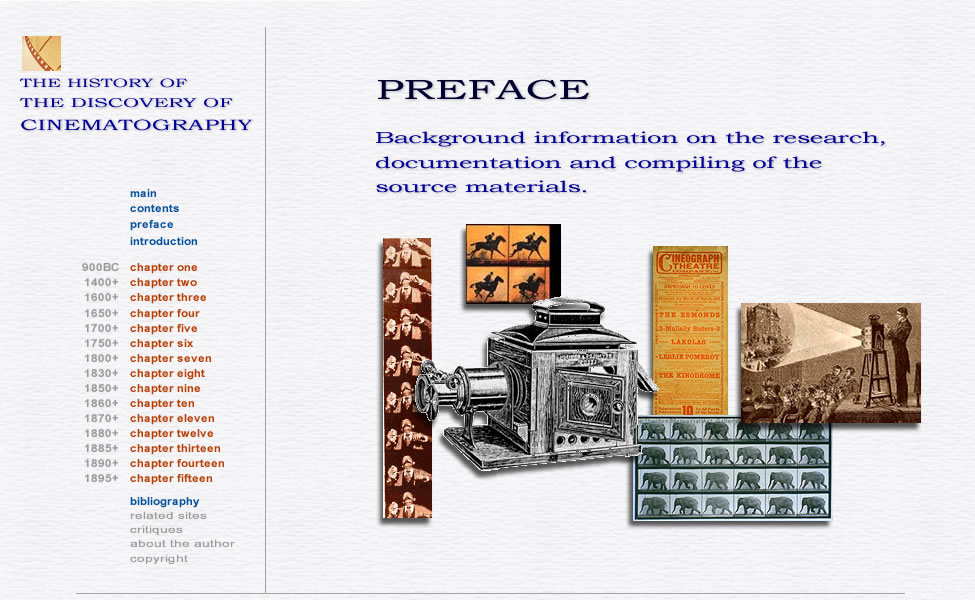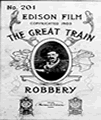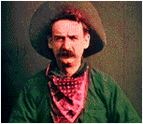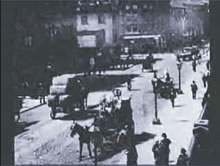 |
| |
| |
|
|
|
| |
 |
This project has been a labour
of love from its inception in 1990. Initially a five hundred-word
piece for a small town newspaper, it has grown into a full-blown
study into the most celebrated art form ever discovered. An on-again,
off-again relationship due to many other commitments, THE HISTORY
OF THE DISCOVERY OF CINEMATOGRAPHY tells the story of how moving
pictures achieved their motion. It includes those responsible
for the numerous inventions designed and built which pointed us
in a cinematic direction. |
|
|
| |
|
|
|
| |
As I have
stated from the beginning, the facts must be presented to allow the reader
the opportunity to decipher and place into context those devices and developments
that fit into history, and discard the rest. |
|
| |
|
|
|
| |
I have always felt it
vital to furnish the necessary elements in full, which even remotely relate
to the fields of photography and cinematography. I believe this timeline
provides a substantial glimpse into that history. My purpose in writing
this book was never to commence any controversy over the genesis of cinema.
I believe the year that it was born (if any) can be deduced by the reader
on the well documented material provided in this text. Our purpose then
is to provide factual data from the earliest possible sources. We will
allow the reader to decide on the importance of genealogy. |
|
| |
|
|
|
| |
I have attempted to compile
and document the history of the discovery from every corner of the subject
and world. The intention was to consider the chronology complete upon
the year 1895 or at least the last decade of the 19th century. This has
been a difficult task to achieve. Not so because of the lack of information
or the obscurity of it. On the contrary, it has been a trying affair,
in that upon new discoveries of commentaries, histories and books, the
story seems not to want to end. This is true more so in the area of the
world wide web. The medium did not exist for this writer when the project
was started. In fact, only from 1997 onward was it used. The bulk of source
material however remains with the printed page. |
|
| |
|
|
| |
 |
|
The film "The Great
Train Robbery" was shot in 1903 by Edwin Porter, and included
this now-famous, yet forgotten scene of one of the outlaws firing
his six shooter directly at the camera. The chamber contained
a blank, but at the time, and for the next decade, this scene
was remembered as one of only a few which in the very early days
of film, scared audiences out of their seats. The Lumiere train
comes to mind as another scary scene never before seen or experienced
by early filmgoers. Ironically, the weapon is fired directly at
the very invention that allows it to be photographed. Porter's
movie has been inaccurately hailed as the first film to tell a
story. The longest to date at 11 (or 12 depending on which cut
you see) minutes in length, The Great Train Robbery allowed the
theatre operator to receive a copy with the gunfighter shooting
at the camera either at the beginning, or end of the film. Far
Left; accompanying poster, Near Left; Eighteen colorized frames
from The Great Train Robbery. |
|
|
| |
|
|
| |
Link upon link provides
more and more information to a point well beyond saturation. However,
for the most part the websites I have found hold the same information
as that in printed form. However, new thoughts and perspectives from historians
have allowed me to peer into the past from multiple angles always tracking
the makers of cinema, always discovering the dates, names and devices
crucial to this chronology. Several of these have been logged in the Bibliography/Webography. |
|
| |
|
|
|
| |
A site that gave us immense
difficulty due to size was Adventures In Cybersound. This was a joy to
discover and pleasure to dissect. Saturation of information is not adequate
enough to explain the sure volume and content of Russell Naughton’s work.
I found this to be a true challenge just from a research point of view.
High marks are given to him and any others attached to that project. His
comments and suggestions are especially appreciated. |
|
| |
|
|
|
| |
In completing the chronology
to 1900, I felt it unwise to close without mentioning some of the many
expansions of the medium up to and including the first decade as well
as some of the milestones attached to the industry, the studios and early
stars. The inclusion of sound and colour for instance were two pivotal
events which gave maturity and a sense of realism to film, if that can
be said. Also, some of the first players and directors deserve mention
if only for their contribution by association. We then leave the chronology,
venturing into the world of the flickering screen, with bullets and trains
heading straight for us, and where a sneeze is the most exciting event
of the day. |
|
| |
|
|
|
| |
Following the initial
public uses of various projectors throughout the world to provide cinema
showings, the medium continued to grow at light-speed. Many of the improvements
to period cameras and projectors were made in the decade they appeared.
Such was the enthusiasm and devotion of the men who spawned this new
and exciting art. However, further discoveries in the next two decades
advanced cinematography into a more complete form just as Muybridge
had suggested when he said;
"The combination of a Kinetoscope and
Phonograph has not been satisfactorily accomplished. There can however
be but little doubt that in the future . . . an entire opera with the
gestures, facial expressions, and songs of the performers with all the
accompanying music, will be recorded and reproduced by an apparatus
for the instruction or entertainment of an audience. And if the photographs
have been made stereoscopically, and each series be independently and
synchronously projected on a screen, a perfectly realistic imitation
of the original performance will be seen, in the apparent "round",
by the use of properly constructed binocular glasses." |
|
| |
|
|
| |
|
|
| |
|
|
| |
| Extant
film: Leeds Bridge Traffic of 1888 from L. A. A. Le Prince
This is the second earliest
strip of film we have today (one frame, right). It
is of the Leeds Bridge in Leeds England, and was photographed
in late October 1888 by LOUIS AIME AUGUSTIN LE PRINCE (1841-1890).
Although never shown publicly, or announced to the world, Le
Prince presented his cinematography of the "Leeds bridge traffic"
in the Whitley factory seven years before the Lumiere's cafe
presentation. Le Prince used non-perforated sensitised paper
for these frames which remain twenty in all. SEE
the Leeds Bridge Traffic come to life HERE. |
|
|
|
| |
|
|
| |
|
|
|
| |
After studying the history
of moving pictures, we must remember that nothing really moves, only the
image on the retina, frame, by frame. |
|
| |
Paul Burns |
|
|
| |
|
|
|
| |
|
|
|
| |
|
|
|

|
| |





